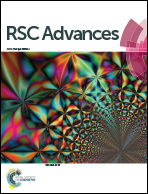Synthesis, photoluminescence and Judd–Ofelt analysis of red LiGd5P2O13 : Eu3+ phosphors for white LEDs
Abstract
A series of LiGd5P2O13 : Eu3+ phosphors with a red-emitting band centered at 622 nm were synthesized by a high temperature solid-state reaction method. Structure-luminescence correlation, concentration quenching and thermal stability of the LiGd5P2O13 : Eu3+ phosphors were studied combined with XRD, PL/PLE spectra as well as temperature-dependent PL and decay curves. The optimum concentration of Eu3+ doped in the LiGd5P2O13 is 20 mol%, and the corresponding concentration quenching mechanism is found to be via dipole/quadrupole–quadrupole interactions. Intensity parameters (Ω2 and Ω4) and various radiative properties such as transition rates (A), branching ratios (β) and stimulated emission cross-section (δe) were calculated using the Judd–Ofelt theory. LiGd5P2O13 : Eu3+ exhibited good thermal stability and its emission intensity decreased slightly at temperature above 150 °C. The CIE coordinates of LiGd5P2O13 : 0.20Eu3+ (0.644, 0.339) are very close to s-RGB standard red (0.640, 0.330), and the corresponding quantum efficiency is 46.5%. The results show that LGPO : Eu3+ may be considered as a potential red emitting phosphor for NUV/blue pumped WLEDs.


 Please wait while we load your content...
Please wait while we load your content...